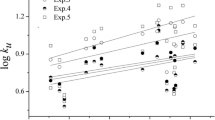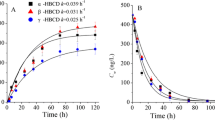Abstract
Applicability of triolein-embedded cellulose acetate membrane (TECAM) to accumulation and potential biological effect assessment for hydrophobic organic contaminants (HOCs) was investigated compared with Japanese medaka. The results of field exposure showed that medaka and TECAMs accumulated contaminants in a similar pattern with good correlations between concentrations in medaka and TECAMs based on lipid weight for OCPs (r = 0.96, p = 0.01, n = 9) and PAHs (r = 0.73, p = 0.01, n = 13). Meanwhile, 2,3,7,8-TCDD equivalents (TEQs) of TECAM extracts detected by in vitro H4IIE cell bioassay corresponded well to hepatic EROD activities of exposed fish and TEQs of water samples. We concluded that TECAM could be utilized as a surrogate for biomonitoring organisms to assess the bioaccumulation of HOCs and potential biological effect.

Similar content being viewed by others
References
Gale RW, Huckins JN, Petty JD, Peterman PH, Williams L, Morse D, Schwartz TR, Tillitt DE (1997) Comparison of the uptake of dioxin-like compounds by caged channel catfish and semipermeable membrane devices in the Saginaw River, Michigan. Environ Sci Technol 31:178–187. doi:10.1021/es960263m
Huckins JN, Tubergen MW, Manuweera GK (1990) Semipermeable membrane devices containing model lipid: a new approach to monitoring the bioavailability of lipophilic contaminants and estimating their bioconcentration potential. Chemosphere 20:533–552. doi:10.1016/0045-6535(90)90110-F
Huckins JN, Petty JD, Booij K (2006) Monitors of organic chemicals in the environment: semipermeable membrane devices. Springer Publishers, New York
Ke RH, Xu YP, Wang ZJ, Khan SU (2006) Estimation of the uptake rate constants for ploycyclic aromatic hydroccarbons accumulated by semipermeable membrane devices and triolein-embedded cellulose acetate membranes. Environ Sci Technol 40:3906–3911. doi:10.1021/es060493t
Ke RH, Li J, Qiao M, Xu YP, Wang ZJ (2007a) Using semipermeable membrane devices, bioassays, and chemical analysis for evaluation of bioavailable polycyclic aromatic hydrocarbons in water. Arch Envrion Contam Toxicol 53:313–320. doi:10.1007/s00244-006-0158-4
Ke RH, Luo JP, Sun LW, Wang ZJ, Spear PA (2007b) Predicting bioavailability and accumulation of organochlorine pesticides by Japanese Medaka in the presence of humic acid and natural organic matter using passive sampling membranes. Environ Sci Technol 41:6698–6703. doi:10.1021/es0707355
Ma TW, Wan XQ, Huang QH, Wang ZJ, Liu JK (2005) Biomarker responses and reproductive toxicity of the effluent from a Chinese large sewage treatment plant in Japanese medaka (Oryzias latipes). Chemosphere 59:281–288. doi:10.1016/j.chemosphere.2004.11.033
Mackay D, Shiu WY, Ma KC (1992) Illustrated handbook of physical-chemical properties and environmental fate for organic compounds. Lewis, Boca Raton, FL, USA
Namieśnik J, Zabiegała B, Kot-Wasik A, Partyka M, Wasik A (2005) Passive sampling and/or extraction techniques in environmental analysis: a review. Anal Bioanal Chem 381:297–301
Petty JD, Jones SB, Huckins JN, Cranor WL, Parris JT, Mctague TB, Boyle TP (2000a) An approach for assessment of water quality using semipermeable membrane devices (SPMDs) and bioindicator tests. Chemosphere 41:311–321. doi:10.1016/S0045-6535(99)00499-3
Petty JD, Orazio CE, Huckins JH, Gale RW, Lebo JA, Meadows JC, Echols KR, Cranor WL (2000b) Considerations involved with the use of semipermeable membrane devices for monitoring environmental contaminants. J Chromatogr A 879:83–95. doi:10.1016/S0021-9673(00)00315-0
Qiao M, Chen YY, Zhang QH, Huang SB, Ma M, Wang CX, Wang ZJ (2006) Identification of Ah receptor agonists in sediment of Meiliang Bay, Taihu Lake, China. Environ Sci Technol 40:1415–1419. doi:10.1021/es051456p
U.S. Environmental Protection Agency (2000) Bioaccumulation testing and interpretation for the purpose of sediment quality assessment: status and needs (EPA-823-R-00-001). Office of Water and Office of Solid Waste
Utvik TIR, Johnsen S (1999) Bioavailability of polycyclic aromatic hydrocarbons in the North Sea. Environ Sci Technol 33:1963–1969. doi:10.1021/es9804215
Van der Oost R, Beyer J, Vermeulen NPE (2003) Fish bioaccumulation and biomarkers in environmental risk assessment: a review. Environ Toxicol Pharmacol 13:57–149. doi:10.1016/S1382-6689(02)00126-6
Villeneuve DL, Khim JS, Kanna K, Giesy JP (2002) Relative potencies of individual polycyclic aromatic hydrocarbons to induce dioxinlike and estrogenic responses in three cell lines. Environ Toxicol 17:128–137. doi:10.1002/tox.10041
Xu Y, Wang Z, Ke R, Khan SU (2005) Accumulation of organochlorine pesticides from water using triolein embedded cellulose acetate membranes. Environ Sci Technol 39:1152–1157. doi:10.1021/es040454m
Acknowledgments
This research has been funded by Chinese Academy of Science (KZCX1-YW-06-02) and Natural Science Foundation of China (40703025, 20621703).
Author information
Authors and Affiliations
Corresponding author
Rights and permissions
About this article
Cite this article
Luo, J., Ma, M., Zha, J. et al. Assessing Accumulation and Biological Effect of Hydrophobic Organic Contaminants in Water Using Caged Japanese Medaka and Deployed Triolein-embedded Cellulose Acetate Membranes. Bull Environ Contam Toxicol 82, 482–487 (2009). https://doi.org/10.1007/s00128-008-9593-4
Received:
Accepted:
Published:
Issue Date:
DOI: https://doi.org/10.1007/s00128-008-9593-4




